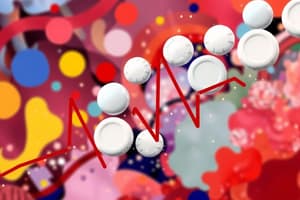Podcast
Questions and Answers
What type of drug is Metoprolol?
What type of drug is Metoprolol?
Class II Antiarrhythmic - Beta-Blocker.
What type of drug is Propranolol?
What type of drug is Propranolol?
Class II Antiarrhythmic - Beta-Blocker.
What type of drug is Esmolol?
What type of drug is Esmolol?
Class II Antiarrhythmic - Beta-Blocker. Very short acting.
What type of drug is Atenolol?
What type of drug is Atenolol?
What type of drug is Timolol?
What type of drug is Timolol?
What type of drug is Carvedilol?
What type of drug is Carvedilol?
What is the mechanism of action for Class II Antiarrhythmics?
What is the mechanism of action for Class II Antiarrhythmics?
What is the clinical use for Class II Antiarrhythmics?
What is the clinical use for Class II Antiarrhythmics?
What is the toxicity associated with Class II Antiarrhythmics?
What is the toxicity associated with Class II Antiarrhythmics?
What is the toxicity associated with Metoprolol and Propranolol?
What is the toxicity associated with Metoprolol and Propranolol?
What type of drug is Amiodarone?
What type of drug is Amiodarone?
What type of drug is Ibutilide?
What type of drug is Ibutilide?
What type of drug is Dofetilide?
What type of drug is Dofetilide?
What type of drug is Sotalol?
What type of drug is Sotalol?
What is the mechanism of action for Class III Antiarrhythmics?
What is the mechanism of action for Class III Antiarrhythmics?
What are the clinical uses for Class III Antiarrhythmics?
What are the clinical uses for Class III Antiarrhythmics?
What is the toxicity associated with Sotalol and Ibutilide?
What is the toxicity associated with Sotalol and Ibutilide?
What is the toxicity associated with Amiodarone?
What is the toxicity associated with Amiodarone?
What special considerations must be made when using Amiodarone?
What special considerations must be made when using Amiodarone?
What type of drug is Verapamil?
What type of drug is Verapamil?
What type of drug is Diltiazem?
What type of drug is Diltiazem?
What is the mechanism of action for Class IV Antiarrhythmic Drugs?
What is the mechanism of action for Class IV Antiarrhythmic Drugs?
What are the clinical uses for Class IV Antiarrhythmic Drugs?
What are the clinical uses for Class IV Antiarrhythmic Drugs?
Flashcards are hidden until you start studying
Study Notes
Class II Antiarrhythmic Drugs
- Metoprolol, Propranolol, Esmolol, Atenolol, Timolol, and Carvedilol are all classified as Class II Antiarrhythmics, specifically beta-blockers.
- Esmolol is noted for its very short acting properties.
- Mechanism of action involves decreasing SA and AV nodal activity, reducing cAMP, which lowers Ca2+ currents, thereby decreasing automaticity and suppressing abnormal pacemakers.
- Clinical applications include treating supraventricular tachycardia (SVT), controlling ventricular rate in atrial fibrillation and flutter, and managing premature beats or ventricular tachycardia.
- Common toxicities include impotence, exacerbation of COPD/asthma, cardiovascular issues (bradycardia, AV block, CHF), CNS effects (sedation, sleep alterations), and masking hypoglycemia signs.
- Specific toxicities: Metoprolol can cause dyslipidemia, while Propranolol may exacerbate Prinzmetal angina and is contraindicated in cocaine users.
Class III Antiarrhythmic Drugs
- Amiodarone, Ibutilide, Dofetilide, and Sotalol are classified as Class III Antiarrhythmics and function as K+ channel blockers.
- Class III drugs increase action potential duration in Purkinje and ventricular muscle fibers by blocking K+ currents during phase 3 repolarization and raise effective refractory periods.
- Clinical uses involve treating atrial fibrillation, atrial flutter, and ventricular tachycardia; they are particularly valuable when other antiarrhythmics fail.
- Sotalol and Ibutilide can lead to torsades de pointes, with Sotalol also causing excessive beta-blockade.
- Amiodarone's toxicities include pulmonary fibrosis, hepatotoxicity, thyroid dysfunctions, corneal deposition, skin deposits causing photodermatitis, neurologic effects, constipation, and cardiovascular issues.
Special Considerations for Amiodarone
- Requires monitoring of pulmonary function tests (PFTs), liver function tests (LFTs), and thyroid function tests (TFTs).
- Notable for having combined effects characteristic of Class I, II, III, and IV drugs and alters the lipid membrane.
Class IV Antiarrhythmic Drugs
- Verapamil and Diltiazem are classified as Class IV Antiarrhythmics, functioning as calcium channel blockers.
- They decrease the rate of rise of phase 0 depolarization and conduction velocity in nodal tissue, which helps reduce reentry mechanisms.
- Clinical applications include prevention of nodal arrhythmias (like PSVT), controlling ventricular rates in atrial fibrillation and flutter, and managing multifocal atrial tachycardia.
- Class IV drugs increase effective refractory periods in the AV node and prolong the PR interval.
Studying That Suits You
Use AI to generate personalized quizzes and flashcards to suit your learning preferences.




